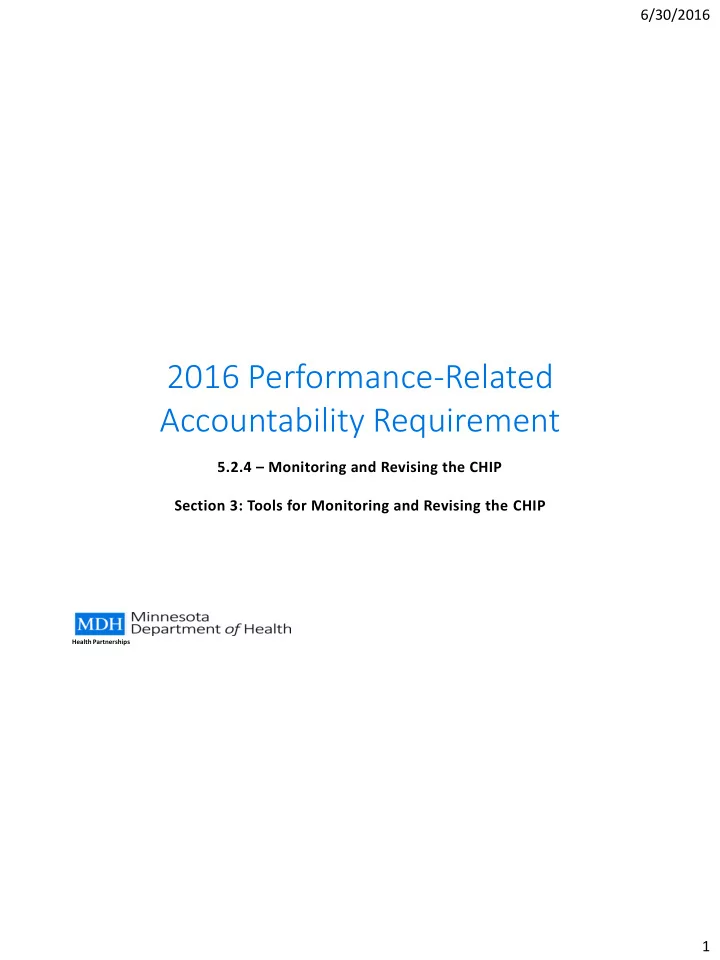

6/30/2016 2016 Performance-Related Accountability Requirement 5.2.4 – Monitoring and Revising the CHIP Section 3: Tools for Monitoring and Revising the CHIP Health Partnerships 1
6/30/2016 Key Concepts Monitor and Revise the CHIP: Differentiate between Population Health Indicators and Performance Measures Using Performance Management 2
6/30/2016 Tools for Monitoring and Revising the CHIP 1. Population Health Indicators 2. Performance Management 3. Performance Measures 3
6/30/2016 Population Health Indicator Data describing a population: Helps quantify the achievement of a result. Often describes health status BRFSS, MSS, Local Surveillance done with SHIP dollars (SHAPE, Bridge4Health), etc. Ties directly to your health priority or goal Note that we’re saying population health indicator, but some data may be simply population-level data and not specific to health 4
6/30/2016 Performance vs Population Health Outcomes Goal/Priority Area Population Changes if we and our partners are doing the right things Population (Health) Indicator Performance Measure Performance Strategies Changes if we’re doing things well 5
6/30/2016 Connecting Population Health and Performance Management Similar process for monitoring performance and population health Performance is monitored more frequently 6
6/30/2016 Performance Management: A systematic process of using data for decision making by identifying outcomes and standards; measuring, monitoring, and communicating progress ; and engaging in quality improvement activities in order to achieve desired outcomes. Minnesota Statute 145A.03, Subd.15a 7 7
6/30/2016 Performance Measure Definition: A measure of how well a program, agency or service system is working. Expressed in a number, percent or standard unit. Answers: How well are we performing? How much did we do? How well did we do it? Is our customer better off? 8
6/30/2016 Where do we want How will we know? to be? Measurement Goals and Objectives Performance Management How well are we How will we doing? improve? Monitoring & Communicating Quality Improvement Progress Minnesota Public Health System Performance Management Cycle 9 9
6/30/2016 Performance Management Model Strong CHIPs have clear goals and Where do we How will we SMART objectives want to be? know? Goals and Objectives Measurement Performance Management How well are How will we we doing? improve? Monitoring & Quality Improvement Communicating Progress http://www.health.state.mn.us/divs/opi/cd/tra ining/events/2016/01_goals-objectives.html 10
6/30/2016 Performance Management Model Measurement is required to Where do we How will we monitor progress want to be? know? Goals and Objectives Measurement Performance Management How well are How will we we doing? improve? Monitoring & Quality Improvement Communicating Progress 11
6/30/2016 Performance Management Model The act of monitoring, Where do we How will we documenting want to be? know? Goals and Objectives Measurement progress in a Performance report, and Management communicating with stakeholders How well are How will we we doing? improve? to monitor Monitoring & Quality Improvement Communicating Progress progress 12
6/30/2016 Performance Management Model Change course if needed based on Where do we How will we monitoring of want to be? know? Goals and Objectives Measurement progress. Performance Management How well are How will we we doing? improve? Monitoring & Quality Improvement Communicating Progress 13
6/30/2016 Performance Management and Monitoring and Revising your CHIP How well are we doing? Monitor Monitoring & Communicating Progress Analyze Revise How will we improve? Quality Improvement 14
6/30/2016 Monitor = Track and Review Actions: Develop a schedule for collecting and reviewing data Assign responsibility Determine where data will come from or how it will be collected How well are we doing? Monitoring & Communicating Progress 15 15
6/30/2016 Analyze = Explain Actions: • Work with stakeholders to explain the data and figure out what it means. Reflect on: • What’s the story behind the numbers? • How does actual performance compare to standard or target? • What is contributing or impeding progress? How well are • Is corrective action necessary? we doing? Monitoring & Communicating Progress 16 16
6/30/2016 Revise = Change Actions: Make revisions in partnership with your community. • May involve Quality Improvement • May not require a full CHIP revision – could be changes to a • work plan, etc. Revisions may be based on: Analysis of performance data Strategies implemented Change in population health indicators New or emerging health issue How will we Changes in resources improve? Quality Improvement 17 17
6/30/2016 Example Community Health Priority: Obesity Goal: Increase healthy eating in youth Population Health Indicator: Increase the percent of youth who eat the recommended number of fruits and vegetables daily from 21% to 30% by 2020. (Data Source: MSS, district level data) Strategy: Healthy Eating in Schools Possible Performance Measures: % of School Health Councils (SCHs) active in last quarter % of SCHs that conduct a needs assessment % of SCHs with written action plan (including a policy statement) to address needs % of schools that review and update wellness policies 18
6/30/2016 Another Example Community Health Priority: Mental Wellbeing Goal: Increase social and emotional wellbeing in youth Population Health Indicator: Decrease the percent of female 9 th graders who have considered suicide in the past 12 months from 18% to 16% by Jan 1 st , 2018. (Data Source: MSS, district level data) Strategy: Train teachers in stigma reduction using “Make it Ok” Possible Performance Measures: %of teachers in XYZ District/School trained in “Make it OK” % of teachers satisfied with “Make it OK” training based on evaluation results % of teachers reporting on evaluation they could talk to a student about mental health after training 19
Recommend
More recommend